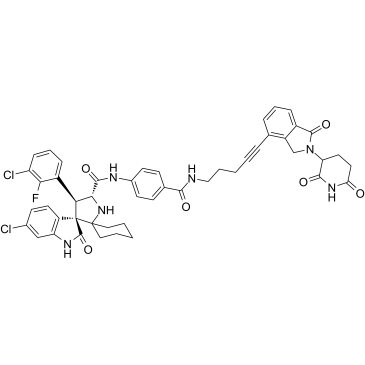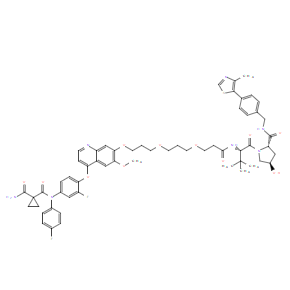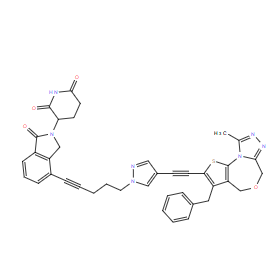 To enhance service speed and avoid tariff delays, we've opened a US warehouse. All US orders ship directly from our US facility.
To enhance service speed and avoid tariff delays, we've opened a US warehouse. All US orders ship directly from our US facility.
| Cat. No. | Product Name | Field of Application | Chemical Structure |
|---|---|---|---|
| DC29016 | NH2-PEG2-C2-Boc |
NH2-PEG2-C2-Boc is a PEG-based PROTAC linker that can be used in the synthesis of PROTACs. NH2-PEG2-C2-Boc is also a non-cleavable 2 unit PEG ADC linker used in the synthesis of antibody-drug conjugates (ADCs).
More description
|

|
| DC28864 | PROTAC BRD4 Degrader-3 |
PROTAC BRD4 Degrader-3 (compound 1004.1) is an efficacious PROTAC BRD4 degrader.
More description
|

|
| DC28802 | PROTAC ER Degrader-4 |
PROTAC ER Degrader-4 is a PROATC estrogen receptor (ER) degrader, binding to ER with an IC50 of 0.8 nM. PROTAC ER Degrader-4 induces ER degradation in MCF-7 cells with an IC50 of 0.3 nM.
More description
|

|
| DC28749 | SJF620 |
SJF620 is a potent PROTAC BTK degrader with a DC50 of 7.9 nM.
More description
|

|
| DC28748 | PROTAC BRD4 Degrader-2 |
PROTAC BRD4 Degrader-2 is an efficacious PROTAC BRD4 degrader with an IC50 of 14.2 nM against BRD4 BD1.
More description
|

|
| DC28747 | PROTAC BRD4 Degrader-1 |
PROTAC BRD4 Degrader-1 is an efficacious BRD4 degrader with an IC50 of 41.8 nM against BRD4 BD1. PROTAC BRD4 Degrader-1 can effectively degrade BRD4 protein and suppress c-Myc expression.
More description
|

|
| DC28736 | INY-03-041 |
INY-03-041 is a potent, highly selective and PROTAC-based pan-AKT degrader consisting of the ATP-competitive AKT inhibitor GDC-0068 conjugated to Lenalidomide. INY-03-041 inhibits AKT1, AKT2 and AKT3 with IC50s of 2.0 nM, 6.8 nM and 3.5 nM, respectively.
More description
|

|
| DC28709 | ARD-266 |
ARD-266 is a a highly potent and VHL E3 ligase-based androgen receptor (AR) PROTAC degrader. ARD-266 effectively induces degradation of AR protein in AR-positive LNCaP, VCaP, and 22Rv1 prostate cancer cell lines with DC50 values of 0.2-1 nM.
More description
|

|
| DC28689 | PROTAC CDK2/9 Degrader-1 |
PROTAC CDK2/9 Degrader-1 (Compound F3) is a potent dual degrader for CDK2 (DC50=62 nM) and CDK9 (DC50=33 nM). PROTAC CDK2/9 Degrader-1 suppresses prostate cancer PC-3 cell proliferation (IC50=0.12 µM) by effectively blocking the cell cycle in S and G2/M phases. PROTAC CDK2/9 Degrader-1 is a PROTAC by tethering CDK inhibitor with CRBN ligand.
More description
|

|
| DC28686 | Azido-PEG4-C2-acid |
Azido-PEG4-C2-acid a PEG-based PROTAC linker can be used in the synthesis of vRucaparib-TP4. Azido-PEG4-C2-acid is also a non-cleavable 4 unit PEG ADC linker used in the synthesis of antibody-drug conjugates (ADCs).
More description
|

|
| DC28680 | PROTAC EED degrader-2 |
PROTAC EED degrader-2 is a PROTAC targeting EED with a pKD of 9.27. PROTAC EED degrader-2 is a polycomb repressive complex 2 (PRC2) inhibitor (pIC50=8.11) targeting the EED subunit.
More description
|

|
| DC28679 | PROTAC EED degrader-1 |
PROTAC EED degrader-1 is a PROTAC targeting EED with a pKD of 9.02. PROTAC EED degrader-1 is a polycomb repressive complex 2 (PRC2) inhibitor (pIC50=8.17) targeting the EED subunit.
More description
|

|
| DC28669 | MS432 |
MS432 is a first-in-class and highly selective PD0325901-based VHL-recruiting PROTAC degrader for MEK1 and MEK2. MS432 displays good plasma exposure in mice, exhibiting DC50 values of 31 nM and 17 nM for MEK1, MEK2 in HT29 cells respectively.
More description
|

|
| DC28664 | Azido-PEG6-alcohol |
Azido-PEG6-alcohol is a PEG-based PROTAC linker that can be used in the synthesis of PROTACs. Azido-PEG6-alcohol is also a non-cleavable 6 unit PEG ADC linker used in the synthesis of antibody-drug conjugates (ADCs).
More description
|

|
| DC28662 | Amino-PEG4-CH2COOH |
Amino-PEG4-CH2COOH is a PEG-based PROTAC linker that can be used in the synthesis of PROTACs. Amino-PEG4-CH2COOH is also a non-cleavable 4 unit PEG ADC linker used in the synthesis of antibody-drug conjugates (ADCs).
More description
|

|
| DC28609 | PROTAC IRAK4 degrader-1 |
PROTAC IRAK4 degrader-1 is a PROTAC interleukin-1 receptor-associated kinase 4 (IRAK4) degrader extracted from patent US20190192668A1 Compound I-210, makes <20%, >20-50%, and >50% IRAK4 degradation at 0.01, 0.1, and 1 μM in OCI-LY-10 cells, respectively.
More description
|

|
| DC28602 | GNE-987 |
GNE-987 is a highly active chimeric BET degrader. GNE-987 exhibits picomolar cell BRD4 degradation activity (DC50=0.03 nM for EOL-1 AML cell line). GNE-987 binds equipotently to the BD1 and BD2 bromodomains of BRD4 with low nanomolar affinities (IC50=4.7 and 4.4 nM, respectively). GNE-987 incorporates a potent BET binder/inhibitor, a VHL-binding fragment, and a ten methylene spacer moiety. GNE-987 can be used in PROTAC-Antibody Conjugate (PAC).
More description
|

|
| DC28601 | (S)-GNE-987 |
(S)-GNE-987 (compound 4), the GNE-987 (a chimeric BET degrader) hydroxy-proline epimer, abrogates binding to VHL and does not degrade BRD4 protein. (S)-GNE-987 binds to the BRD4 BD1(IC50=4 nM) and BD2 (3.9 nM) bromodomains and can be used to design PROTAC-Antibody Conjugate (PAC).
More description
|

|
| DC28600 | KB02-JQ1 |
KB02-JQ1 is a highly selective and PROTAC-based BRD4 degrader (molecular glue), but does not degrade BRD2 or BRD3. KB02-JQ1 promotes BRD4 degradation by covalently modifying DCAF16 (E3 ligase) and can improve the durability of protein degradation in biological systems. JQ1 binds ubiquitin E3 ligase ligand KB02 via a linker to form KB02-JQ1.
More description
|

|
| DC28582 | Halo PROTAC 1 |
Halo PROTAC 1 is a PROTAC, which is a ligand having activity to bind to an intracellular proteins fused with HaloTag and a structure having activity to induce autophagy of an intracellular molecule are linked via a PEG linker.
More description
|

|
| DC28580 | NH2-PEG5-OH |
NH2-PEG5-OH is a PEG-based PROTAC linker that can be used in the synthesis of PROTACs. NH2-PEG5-OH is also a non-cleavable 5 unit PEG ADC linker used in the synthesis of antibody-drug conjugates (ADCs).
More description
|

|
| DC28578 | KB02-SLF |
KB02-SLF is a PROTAC-based nuclear FKBP12 degrader (molecular glue). KB02-SLF promotes nuclear FKBP12 degradation by covalently modifying DCAF16 (E3 ligase) and can improve the durability of protein degradation in biological systems. SLF binds ubiquitin E3 ligase ligand KB02 via a linker to form KB02-SLF.
More description
|

|
| DC28514 | THP-PEG6-OH |
THP-PEG6-OH is a PEG-based PROTAC linker that can be used in the synthesis of PROTACs. THP-PEG6-OH is also a non-cleavable 3 unit PEG ADC linker used in the synthesis of antibody-drug conjugates (ADCs).
More description
|

|
| DC28314 | Aminooxy-PEG2-azide |
Aminooxy-PEG2-azide is a PEG-based PROTAC linker that can be used in the synthesis of PROTACs. Aminooxy-PEG2-azide is also a non-cleavable 2 unit PEG ADC linker used in the synthesis of antibody-drug conjugates (ADCs).
More description
|

|
| DC28165 | dFKBP-1 |
dFKBP-1 is a potent and PROTAC-based FKBP12 degrader. dFKBP-1 incorporates the ligand SLF of FKBP12, the Thalidomide based cereblon ligand and a linker.
More description
|

|
| DC28018 | MD-224 Featured |
MD-224 is a first-in-class and highly potent small-molecule human murine double minute 2 (MDM2) degrader based on the proteolysistargeting chimera (PROTAC) concept. MD-224 induces rapid degradation of MDM2 at concentrations <1 nM in human leukemia cells, and achieves an IC50 value of 1.5 nM in inhibition of growth of RS4;11 cells. MD-224 has the potential to be a new class of anticancer agent.
More description
|

|
| DC11001 | Foretinib-Based PROTAC 7 |

|
|
| DC11584 | SNIPER(ABL)-062 |
SNIPER(ABL)-062 is a novel, potent SNIPER molecule that tethers BCR-ABL inhibitor to a ligand of IAP, causes potent BCR-ABL degradation.
More description
|

|
| DC11040 | QCA570 |
QCA570 is a novel, highly potent efficacious BET degrader (PROTAC).
More description
|

|
| DC10932 | HDAC6 degrader 9c |
HDAC6 degrader 9c (dHDAC6 9c) is a bifunctional molecule (dHDAC6) that could selectively degrade HDAC6, by conjugating non-selective HDAC inhibitor to a thalidomide-type E3 ligase ligand.
More description
|

|